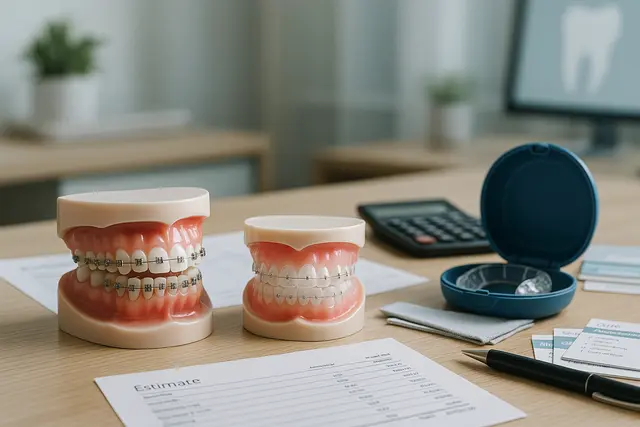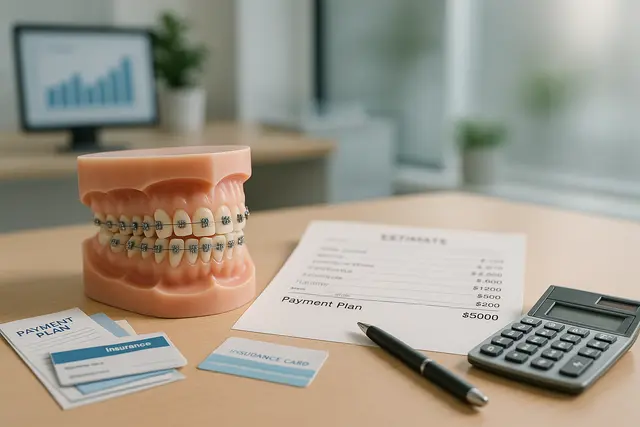Orthodontics
5 min read
Apr 03, 2025
Metal Braces vs. Ceramic Braces: Pros, Cons, and Best Candidates
Metal braces are the traditional choice, strong, visible, and often recommended for more intensive corrections. Ceramic braces, on the other hand, offer a lower-profile, more discreet look but are usually less durable and more expensive.

One of the most common worries people have when they decide to get braces is simple: which type of brace will fit my life? The classic shine of metal braces or the subtle style of ceramic braces? Both straighten teeth, both use a tiny bracket on every tooth, yet the daily experience can feel worlds apart. Below you’ll find a clear‑cut, slightly humorous guide that compares strengths, weaknesses, and ideal wearers, without stiff jargon or sleepy prose.
Orthodontic Basics
Every orthodontist starts with the same playbook. A medical‑grade bracket (think postage‑stamp sized) is bonded to each tooth, a flexible metal archwire snaps in, and controlled tension begins the slow dance we call orthodontic treatment. Whether you choose metal braces or ceramic braces, the underlying science in orthodontics remains identical. The real split lies in the materials that touch your smile, and how visible those materials are during family photos.
Metal Braces Explained
Metal braces are the traditional type of braces many of us remember from school yearbooks. They use brackets made of stainless steel plus metal wires that deliver serious horsepower. Because steel loathes cracking, metal braces are more durable than almost every alternative, so athletes and popcorn enthusiasts can breathe easy. Treatment time can be a touch faster too, because your doctor isn’t baby‑sitting fragile parts. On the flip side, visible metal brackets reflect every flash bulb at a wedding. Some folks embrace the sparkle; others feel it’s one party trick too many.
Ceramic Braces Overview
Ceramic braces, sometimes called clear braces, swap steel for a glass‑infused ceramic material that comes in tooth‑colored shades. Clear or tooth‑colored brackets blend in so well that coworkers may never notice you’re straightening your smile. Ceramic braces are less visible and certainly less noticeable than traditional metal braces, making them perfect for public‑facing professionals. The catch? Ceramic braces are less durable than metal braces. A surprise elbow or a hard baguette can crack a ceramic bracket, and ceramic braces may take longer because orthodontists apply gentler forces to avoid breakage. Add coffee stains to the mix (ceramic ones hold pigment like a sponge) and you’ll see why lifestyle matters.
Metal and Ceramic Braces Head‑to‑Head
Metal braces use brackets that laugh at torque, allowing bolder, quicker tooth movements. Ceramic braces tend to need lighter turns of the archwire, meaning complex rotations can take longer than metal braces. Metal braces are the traditional sprinter; ceramic braces offer a more discreet marathon. If you crave speed and strength, metal braces are right on target. If you value a subtle grin during client meetings, consider ceramic braces instead.
Clear Braces, Invisible Hopes
Quick detour: clear braces is simply another nickname for ceramic braces, not an entirely new gadget. Called clear braces because they blend with enamel, they still attach to each tooth and rely on elastic rings. Don’t confuse them with removable trays.
Treatment Time and Durability
Treatment time hinges on tooth drama. Severe crowding usually finishes faster in steel, while mild spacing often sees no difference between ceramic versus metal. Because ceramic braces tend to chip, a single cracked bracket can add weeks. Braces may require extra care in sports or when munching on crusty bread. Metal brackets shrug at those hazards.
Braces Cost
Braces cost real money, Nobody’s secret. Ceramic options cost more than metal braces, typically 20–30 percent higher, because ceramic material is pricier and repairs take longer. Insurance often covers both, but always confirm. If budget is tight yet you still crave subtlety, many doctors mix metal and ceramic braces, ceramic up top for selfies, metal on the bottom for bite muscle.
Comfort and Looks
If visibility nags you, ceramic braces offer a stealth upgrade. A white archwire and clear elastics keep cameras focused on your eyes, not your hardware. Metal braces, on the other hand, own the look of metal; some patients double down with neon bands for fun. Just remember ceramic brackets stain easily, so curry night means immediate brushing.
Choosing Between Ceramic and Metal
The best braces meet your habits, wallet, and patience level. Presentation coach? Ceramic braces provide quiet confidence under stage lights. Rugby player? Metal braces are more durable. Coffee lover with whitening obsession? Ceramic braces are less noticeable than metal but demand diligent cleaning. Kids who chew pens should stick to stainless steel brackets. Braces may be more suitable in ceramic form for adults who want subtlety and can baby their gear; metal ones rule when rugged resilience matters.
Get Ceramic Braces or Get Braces at All?
Ready to get ceramic braces? Ask whether you can wear ceramic on the visible upper teeth while keeping stainless steel brackets on molars for strength, a setup nicknamed metal and ceramic braces. Thinking you’ll just get braces later? Crowding rarely fixes itself, and early correction often means shorter treatment time.
Special Situations
People who grind their teeth at night, musicians who play brass instruments, or chefs who taste‑test tomato sauce daily should discuss lifestyle with their orthodontist. Ceramic braces usually satisfy presenters and influencers; metal braces often make more sense for extreme sports. Either way, braces provide a proven route to a healthier bite.
Best Candidates
Braces are suitable for nearly everyone, but ceramic braces shine for image‑conscious adults, while metal braces remain the champion for teens who forget mouthguards. If you still can’t decide, picture your smile on your wedding day, then picture the bill. The answer usually pops out.
Final Thoughts
Metal braces remain the gold standard for strength, and ceramic braces offer a discreet path for those who hate flashing silver. Both systems straighten teeth brilliantly when cared for, both rely on the same steady orthodontic treatment, and both demand you show up for tightening appointments. So weigh your priorities, chat with a knowledgeable orthodontist, and pick the gear you’ll happily wear for the next year or two. Straight teeth, after all, never go out of style.
What Is the Main Difference Between Metal and Ceramic Braces?
The biggest difference is visibility. Metal braces are more noticeable but highly durable, while ceramic braces blend in with your teeth for a more discreet look. Both types work the same way, but ceramic brackets are slightly more fragile and can stain.
Do Ceramic Braces Take Longer Than Metal Braces?
They can. Because ceramic brackets are more delicate, orthodontists may use lighter forces, which could extend treatment time, especially for complex tooth movements. Metal braces typically move teeth faster thanks to their durability and strength.
Are Ceramic Braces More Expensive Than Metal Braces?
Yes, ceramic braces usually cost 20–30% more than metal braces. The materials are pricier, and repairs take longer if brackets chip. However, some people opt for a hybrid setup with ceramic on top and metal on the bottom to balance cost and aesthetics.
Who Should Choose Metal Braces Over Ceramic Ones?
Metal braces are best for patients who play contact sports, grind their teeth, or need faster, more rugged treatment. They're also ideal for kids and teens who may be less careful with their brackets. Ceramic braces are great for adults or anyone prioritizing appearance.
Read Next
Related Posts

Orthodontics
Retainer That Looks like Braces: Benefits for Long-Term Alignment
A retainer might not get as much attention as braces, but it plays a crucial role in maintaining your smile after orthodontic treatment. Whether you're new to retainers or curious about the type that looks like braces, understanding their purpose and benefits is key to keeping your teeth aligned for the long haul.
6 min read
Sep 15, 2025

Orthodontics
How Much Are Metal Braces? Cost Comparison With Other Options
Thinking about getting braces but overwhelmed by the cost? You’re not alone. Orthodontic treatment can be a major investment, and understanding the different price points, from metal braces to clear aligners, can help you make a smart, confident decision.
5 min read
Sep 15, 2025

Orthodontics
Orthodontics & Braces Statistics (Adults + Kids)
Orthodontics has transformed from a niche medical service for teenagers into a booming sector that spans all ages. Today, both adults and children seek orthodontic treatment to improve their smiles, fix bite issues, and boost self-confidence.
4 min read
Aug 21, 2025
Don’t have time to research every dentist around you?
See why 30k+ patients trusted us